GATE 2023 Statistics (ST) Question Paper PDF is available here for download. IIT Kanpur conducted GATE 2023 Statistics exam on February 12, 2023 in the Forenoon Session from 09:30 AM to 12:30 PM. Students have to answer 65 questions in GATE 2023 Statistics Question Paper carrying a total weightage of 100 marks. 10 questions are from the General Aptitude section and 55 questions are from Engineering Mathematics and Core Discipline.
GATE 2023 Statistics (ST) Question Paper with Solutions PDF
| GATE 2023 Statistics (ST) Question Paper with Solutions | Check Solutions |

“I have not yet decided what I will do this evening; I _________ visit a friend.”
Eject : Insert :: Advance : ______ (By word meaning)
In the given figure, PQRSTV is a regular hexagon with each side of length 5 cm. A circle is drawn with its centre at V such that it passes through P. What is the area (in cm\(^2\)) of the shaded region? (The diagram is representative)

A duck named Donald Duck says “All ducks always lie.” Based only on the information above, which one of the following statements can be logically inferred with certainty?
A line of symmetry is defined as a line that divides a figure into two parts in a way such that each part is a mirror image of the other part about that line. The figure below consists of 20 unit squares arranged as shown. In addition to the given black squares, up to 5 more may be coloured black. Which one among the following options depicts the minimum number of boxes that must be coloured black to achieve two lines of symmetry? (The figure is representative)

Based only on the truth of the statement ‘Some humans are intelligent’, which one of the following options can be logically inferred with certainty?
Which one of the options can be inferred about the mean, median, and mode for the given probability distribution (i.e. probability mass function), \(P(x)\), of a variable \(x\)?

The James Webb telescope, recently launched in space, is giving humankind unprecedented access to the depths of time by imaging very old stars formed almost 13 billion years ago. Astrophysicists and cosmologists believe that this odyssey in space may even shed light on the existence of dark matter. Dark matter is supposed to interact only via the gravitational interaction and not through the electromagnetic-, the weak- or the strong-interaction. This may justify the epithet “dark” in dark matter.
Based on the above paragraph, which one of the following statements is FALSE?
Let \(a = 30!\), \(b = 50!\), and \(c = 100!\). Consider the following numbers: \(\log_a c\), \(\log_c a\), \(\log_b a\), \(\log_a b\)
Which one of the following inequalities is CORRECT?
A square of side length 4 cm is given. The boundary of the shaded region is defined by one semi-circle on the top and two circular arcs at the bottom, each of radius 2 cm, as shown. The area of the shaded region is ______ cm\(^2\).

The area of the region bounded by the parabola \( x = -y^2 \) and the line \( y = x + 2 \) equals
Let \( A \) be a \( 3 \times 3 \) real matrix having eigenvalues \( 1, 0, \) and \( -1 \). If \( B = A^2 + 2A + I_3 \), where \( I_3 \) is the \( 3 \times 3 \) identity matrix, then which one of the following statements is true?
Consider the following statements.
(I) Let A and B be two n \times n real matrices. If B is invertible, then rank(BA) = rank(A).
(II) Let A be an n \times n real matrix. If A^2x = b has a solution for every b \in \mathbb{R^n, then Ax = b also has a solution for every b \in \mathbb{R^n.
Which of the above statements is/are true?
Consider the probability space \((\Omega, \mathcal{G}, P)\), where \(\Omega = [0,2]\) and \(\mathcal{G} = \{\emptyset, \Omega, [0,1], (1,2]\}\). Let \(X\) and \(Y\) be two functions on \(\Omega\) defined as
\[ X(\omega) = \begin{cases} 1 & if \omega \in [0,1]
2 & if \omega \in (1,2] \end{cases} \]
and
\[ Y(\omega) = \begin{cases} 2 & if \omega \in [0,1.5]
3 & if \omega \in (1.5,2] \end{cases} \]
Then which one of the following statements is true?
Let \( \Phi(\cdot) \) denote the cumulative distribution function of a standard normal random variable. If the random variable \( X \) has the cumulative distribution function \[ F(x) = \begin{cases} \Phi(x) & if x < -1,
\Phi(x + 1) & if x \geq -1, \end{cases} \]
then which one of the following statements is true?
Let \( X \) be a random variable with probability density function \[ f(x) = \begin{cases} \alpha \lambda x^{\alpha - 1} e^{-\lambda x^\alpha} & if x > 0
0 & otherwise \end{cases} \]
where \( \alpha > 0 \) and \( \lambda > 0 \). If the median of \( X \) is 1 and the third quantile is 2, then \( (\alpha, \lambda) \) equals:
Let \( X \) be a random variable having Poisson distribution with mean \( \lambda > 0 \). Then \( E \left( \frac{1}{X+1} \mid X > 0 \right) \) equals:
Suppose that \( X \) has the probability density function \[ f(x) = \begin{cases} \frac{\lambda^{\alpha}}{\Gamma(\alpha)} x^{\alpha-1} e^{-\lambda x} & if x > 0
0 & otherwise, \end{cases} \]
where \( \alpha > 0 \) and \( \lambda > 0 \). Which one of the following statements is NOT true?
Let \( (X, Y) \) have joint probability density function \[ f(x, y) = \begin{cases} 8xy & if 0 < x < y < 1
0 & otherwise. \end{cases} \]
If \( E(X | Y = y_0) = \frac{1{2} \), then \( y_0 equals \)
Suppose that there are 5 boxes, each containing 3 blue pens, 1 red pen and 2 black pens. One pen is drawn at random from each of these 5 boxes. If the random variable X_1 denotes the total number of blue pens drawn and the random variable X_2 denotes the total number of red pens drawn, then P(X_1 = 2, X_2 = 1) equals:
Let \( \{X_n\}_{n \geq 1} \) and \( \{Y_n\}_{n \geq 1} \) be two sequences of random variables and \( X \) and \( Y \) be two random variables, all of them defined on the same probability space. Which one of the following statements is true?
Let \( X \) be a random variable with probability density function \[ f(x; \lambda) = \begin{cases} \frac{1}{\lambda} e^{- \frac{x}{\lambda}} & if x > 0
0 & otherwise \end{cases} \]
where \( \lambda > 0 \) is an unknown parameter. Let \( Y_1, Y_2, \ldots, Y_n \) be a random sample of size \( n \) from a population having the same distribution as \( X^2 \). If \( \overline{Y} = \frac{1}{n} \sum_{i=1}^{n} Y_i \), then which one of the following statements is true?
Let X_1, X_2, \dots, X_n be a random sample of size n (\geq 2) from a population having probability density function \[ f(x; \theta) = \left\{ \begin{array{ll} \frac{2}{\theta} \left( -\log_e x \right)^2 e^{-\left( \frac{\log_e x}{\theta} \right)^2} & if 0 < x < 1
0 & otherwise \end{array} \right. \]
where \( \theta > 0 \) is an unknown parameter. Then which one of the following statements is true?
Let \( X_1, X_2, \dots, X_n \) be a random sample of size \( n \) from a population having uniform distribution over the interval \( \left( \frac{1}{3}, \theta \right) \), where \( \theta > \frac{1}{3} \) is an unknown parameter. If \( Y = \max \{ X_1, X_2, \dots, X_n \} \), then which one of the following statements is true?
Suppose that \( X_1, X_2, \dots, X_n, Y_1, Y_2, \dots, Y_n \) are independent and identically distributed random vectors each having \( N_p(\mu, \Sigma) \) distribution, where \( \Sigma \) is non-singular, \( p > 1 \) and \( n > 1 \). If \( \overline{X} = \frac{1}{n} \sum_{i=1}^n X_i \) and \( \overline{Y} = \frac{1}{n} \sum_{i=1}^n Y_i \), then which one of the following statements is true?
Consider the following regression model \[ y_k = \alpha_0 + \alpha_1 \log k + \epsilon_k, \quad k = 1, 2, \dots, n, \]
where \( \epsilon_k are independent and identically distributed random variables each having probability density function \ f(x) = \frac{1{2 e^{-|x|, \ x \in \mathbb{R. Then which one of the following statements is true?
Suppose that \(X_1, X_2, \dots, X_n\) are independent and identically distributed random variables each having probability density function \(f(\cdot)\) and median \(\theta\). We want to test \[ H_0: \theta = \theta_0 \quad against \quad H_1: \theta > \theta_0. \]
Consider a test that rejects \(H_0\) if \(S > c\) for some \(c\) depending on the size of the test, where \(S\) is the cardinality of the set \(\{i: X_i > \theta_0, 1 \leq i \leq n\}\). Then which one of the following statements is true?
Suppose that \(x\) is an observed sample of size 1 from a population with probability density function \(f(\cdot)\). Based on \(x\), consider testing \[ H_0: f(y) = \frac{1}{\sqrt{2\pi}} e^{-y^2/2}, \quad y \in \mathbb{R} \quad against \quad H_1: f(y) = \frac{1}{2} e^{-|y|}, \quad y \in \mathbb{R}. \]
Then which one of the following statements is true?
Let \( f: \mathbb{R}^2 \rightarrow \mathbb{R} \) be defined by \( f(x, y) = xy \). Then the maximum value (rounded off to two decimal places) of \( f \) on the ellipse \( x^2 + 2y^2 = 1 \) equals ________.
Let \( A \) be a \( 2 \times 2 \) real matrix such that \( AB = BA \) for all \( 2 \times 2 \) real matrices \( B \). If the trace of \( A \) equals 5, then the determinant of \( A \) (rounded off to two decimal places) equals ________.
Two defective bulbs are present in a set of five bulbs. To remove the two defective bulbs, the bulbs are chosen randomly one by one and tested. If \( X \) denotes the minimum number of bulbs that must be tested to find out the two defective bulbs, then \( P(X = 3) \) (rounded off to two decimal places) equals:
Let \( \{X_n\}_{n \geq 1} \) be a sequence of independent and identically distributed random variables, each having mean 4 and variance 9. If \( Y_n = \frac{1}{n} \sum_{i=1}^{n} X_i \) for \( n \geq 1 \), then \[ \lim_{n \to \infty} E \left[ \left( \frac{Y_n - 4}{\sqrt{n}} \right)^2 \right] (in integer) equals: \]
Let \{W_t\_{t \geq 0 be a standard Brownian motion. Then E(W_4^2 | W_2 = 2) (in integer) equals:
Let \{X_n\_{n \geq 1 be a Markov chain with state space \{1, 2, 3\ and transition probability matrix \[ P = \begin{bmatrix \frac{1}{2} & \frac{1}{4} & \frac{1}{4}
\frac{1}{3} & \frac{1}{3} & \frac{1}{3}
0 & \frac{1}{2} & \frac{1}{2} \end{bmatrix} \]
Then P(X_2 = 1 | X_1 = 1, X_3 = 2) (rounded off to two decimal places) equals:
Suppose that \( (X_1, X_2, X_3) \) has a \( N_3(\mu, \Sigma) \) distribution with \[ \mu = \begin{pmatrix} 0
0 \end{pmatrix} \quad and \quad \Sigma = \begin{pmatrix} 2 & 2 & 1
2 & 5 & 1
1 & 1 & 1 \end{pmatrix}. \]
Given that \( \Phi(-0.5) = 0.3085 \), where \( \Phi(\cdot) \) denotes the cumulative distribution function of a standard normal random variable, \[ P\left( (X_1 - 2X_2 + 2X_3)^2 < \frac{7{2} \right) \quad (rounded off to two decimal places) equals \_\_\_\_\_\_\_\_ \]
Let \( A \) be an \( n \times n \) real matrix. Consider the following statements.
(I) If \( A \) is symmetric, then there exists \( c \geq 0 \) such that \( A + c I_n \) is symmetric and positive definite, where \( I_n \) is the \( n \times n \) identity matrix.
(II) If \( A \) is symmetric and positive definite, then there exists a symmetric and positive definite matrix \( B \) such that \( A = B^2 \).
Which of the above statements is/are true?
Let \(X\) be a random variable with probability density function \[ f(x) = \begin{cases} \frac{1}{x^2} & if x \geq 1,
0 & otherwise. \end{cases} \]
If \(Y = \log X\), then \(P(Y < 1 \mid Y < 2)\) equals
Let \(\{N(t)\}_{t \geq 0}\) be a Poisson process with rate 1. Consider the following statements.
[(I)] \(P(N(3) = 3 \mid N(5) = 5) = \binom{5}{3} \left(\frac{3}{5}\right)^3 \left(\frac{2}{5}\right)^2\).
[(II)] If \(S_5\) denotes the time of occurrence of the 5th event for the above Poisson process, then \(E(S_5 \mid N(5) = 3) = 7\).
Which of the above statements is/are true?
Let \( X_1, X_2, \dots, X_n \) be a random sample of size \( n \) from a population having probability density function \[ f(x; \mu) = \begin{cases} e^{-(x-\mu)} & if \mu \leq x < \infty
0 & otherwise \end{cases} \]
where \( \mu \in \mathbb{R} \) is an unknown parameter. If \( \hat{M} \) is the maximum likelihood estimator of the median of \( X_1 \), then which one of the following statements is true?
Let \( X_1, X_2, \dots, X_{10} \) be a random sample of size 10 from a population having \( N(0, \theta^2) \) distribution, where \( \theta > 0 \) is an unknown parameter.
Let \( T = \frac{1}{10} \sum_{i=1}^{10} X_i^2 \). If the mean square error of \( cT \) (for \( c > 0 \)), as an estimator of \( \theta^2 \), is minimized at \( c = c_0 \), then the value of \( c_0 \) equals
Suppose that \( X_1, X_2, \dots, X_{10} \) are independent and identically distributed random vectors each having \( N_2(\mu, \Sigma) \) distribution, where \( \Sigma \) is non-singular. If \[ U = \frac{1}{1 + (\bar{X} - \mu)^T \Sigma^{-1} (\bar{X} - \mu)} \]
where \( \bar{X = \frac{1}{10} \sum_{i=1}^{10} X_i \), then the value of \[ \log_e P(U \leq \frac{1}{2}) equals: \]
Suppose that \( (X, Y) \) has joint probability mass function \[ P(X = 0, Y = 0) = P(X = 1, Y = 1) = \theta, \quad P(X = 1, Y = 0) = P(X = 0, Y = 1) = \frac{1}{2} - \theta, \]
where \( 0 \leq \theta \leq \frac{1{2} \) is an unknown parameter. Consider testing \( H_0 : \theta = \frac{1}{4} \) against \( H_1 : \theta = \frac{1}{3} \), based on a random sample \[ \{ (X_1, Y_1), (X_2, Y_2), \dots, (X_n, Y_n) \} \]
from the above probability mass function. Let \( M \) be the cardinality of the set \[ \{ i : X_i = Y_i, 1 \leq i \leq n \, \]
If \( m \) is the observed value of \( M \), then which one of the following statements is true?
Let g(x) = f(x) + f(2 - x) for all x \in [0, 2], where f : [0, 2] \to \mathbb{R is continuous on [0, 2] and twice differentiable on (0, 2). If g' denotes the first derivative of g and f'' denotes the second derivative of f, then which of the following statements is NOT true?
For any subset \( U \) of \( \mathbb{R}^n \), let \( L(U) \) denote the span of \( U \). For any two subsets \( T \) and \( S \) of \( \mathbb{R}^n \), which one of the following statements is NOT true?
Let \( f \) be a continuous function from \( [0, 1] \) to the set of all real numbers. Then which one of the following statements is NOT true?
Let \( X \) be a random variable with cumulative distribution function \[ F(x) = \begin{cases} 0 & if x < -1
\frac{1}{4}(x + 1) & if -1 \leq x < 0
\frac{1}{4}(x + 3) & if 0 \leq x < 1
1 & if x \geq 1 \end{cases} \]
Which one of the following statements is true?
Let \((X, Y)\) have joint probability mass function \[ p(x, y) = \begin{cases} \frac{c}{2x + y + 2} & if x = 0, 1, 2, \dots; \, y = 0, 1, 2, \dots; \, x \neq y,
0 & otherwise. \end{cases} \]
Then which one of the following statements is true?
Let \(X_1, X_2, \dots, X_{10}\) be a random sample of size 10 from a \(N_3(\mu, \Sigma)\) distribution, where \(\mu\) and non-singular \(\Sigma\) are unknown parameters. If \[ \overline{X_1} = \frac{1}{5} \sum_{i=1}^{5} X_i, \quad \overline{X_2} = \frac{1}{5} \sum_{i=6}^{10} X_i, \] \[ S_1 = \frac{1}{4} \sum_{i=1}^{5} (X_i - \overline{X_1})(X_i - \overline{X_1})^T, \quad S_2 = \frac{1}{4} \sum_{i=6}^{10} (X_i - \overline{X_2})(X_i - \overline{X_2})^T, \]
then which one of the following statements is NOT true?
Which of the following sets is/are countable?
For a given real number \( a \), let \( a^+ = \max\{a, 0\} \) and \( a^- = \max\{-a, 0\} \). If \( \{x_n\}_{n \geq 1} \) is a sequence of real numbers, then which of the following statements is/are true?
Let \( A \) be a \( 3 \times 3 \) real matrix such that \[ A \begin{bmatrix} 1
1
0 \end{bmatrix} = \begin{bmatrix} 0
4
0 \end{bmatrix}, \quad A \begin{bmatrix} 0
1
1 \end{bmatrix} = \begin{bmatrix} 4
0
0 \end{bmatrix}, \quad A \begin{bmatrix} 1
0
1 \end{bmatrix} = \begin{bmatrix} 0
0
4 \end{bmatrix}. \]
Then which of the following statements is/are true?
Let \( X \) be a positive valued continuous random variable with finite mean. If \( Y = \lfloor X \rfloor \), the largest integer less than or equal to \( X \), then which of the following statements is/are true?
Let X be a random variable with probability density function \[ f(x) = \begin{cases e^{-x} & if x \geq 0
0 & otherwise \end{cases} \]
For \( a < b \), if \( U(a, b) \) denotes the uniform distribution over the interval \( (a, b) \), then which of the following statements is/are true?
Suppose that X is a discrete random variable with the following probability mass function: \[ P(X = 0) = \frac{1{2}(1 + e^{-1}), \quad P(X = k) = \frac{e^{-1}}{2 k!} for k = 1, 2, 3, \dots \]
Which of the following statements is/are true?
Suppose that \( U \) and \( V \) are two independent and identically distributed random variables each having probability density function \[ f(x) = \begin{cases} \lambda^2 x e^{-\lambda x} & if x > 0
0 & otherwise, \end{cases} \]
where \( \lambda > 0 \). Which of the following statements is/are true?
Let \( (X, Y) \) have joint probability mass function \[ p(x, y) = \begin{cases} \frac{e^{-2}}{x! (y - x)!} & if x = 0, 1, 2, \dots, y; \, y = 0, 1, 2, \dots
0 & otherwise. \end{cases} \]
Then which of the following statements is/are true?
Let \(\{X_n\}_{n \geq 1}\) be a sequence of independent and identically distributed random variables with mean 0 and variance 1, all of them defined on the same probability space. For \(n = 1, 2, 3, \dots\), let \[ Y_n = \frac{1}{n} \left( X_1 X_2 + X_3 X_4 + \dots + X_{2n-1} X_{2n} \right). \]
Then which one of the following statements is/are true?
Consider the following regression model \[ y_t = \alpha_0 + \alpha_1 t + \alpha_2 t^2 + \epsilon_t, \quad t = 1, 2, \dots, 100, \]
where \(\alpha_0, \alpha_1, \alpha_2\) are unknown parameters and \(\epsilon_t\)'s are independent and identically distributed random variables each having \(N(\mu, 1)\) distribution with \(\mu \in \mathbb{R}\) unknown. Then which one of the following statements is/are true?
Consider the orthonormal set \[ v_1 = \begin{bmatrix} \frac{1}{\sqrt{3}}
\frac{1}{\sqrt{3}}
\frac{1}{\sqrt{3}} \end{bmatrix}, v_2 = \begin{bmatrix} \frac{1}{\sqrt{6}}
\frac{2}{\sqrt{6}}
\frac{1}{\sqrt{6}} \end{bmatrix}, v_3 = \begin{bmatrix} \frac{1}{\sqrt{2}}
0
\frac{1}{\sqrt{2}} \end{bmatrix} \]
with respect to the standard inner product on \( \mathbb{R}^3 \). If \( u = \begin{bmatrix} a
b
c \end{bmatrix} \) is the vector such that inner products of \( u \) with \( v_1, v_2 \) and \( v_3 \) are 1, 2 and 3, respectively, then \( a^2 + b^2 + c^2 \) (in integer) equals ________.
Consider the probability space \( (\Omega, \mathcal{G}, P) \), where \( \Omega = \{1, 2, 3, 4\} \), \[ \mathcal{G} = \{\emptyset, \Omega, \{4\}, \{2, 3\}, \{1, 4\}, \{1, 2, 3\}, \{2, 3, 4\}\}, \]
and \( P(\{1\}) = \frac{1}{4} \). Let \( X \) be the random variable defined on the above probability space as \[ X(1) = 1, X(2) = X(3) = 2, X(4) = 3. \]
If \( P(X \leq 2) = \frac{3}{4} \), then \( P(\{1, 4\}) \) (rounded off to two decimal places) equals ________.
Let \( \{ X_n \}_{n \geq 1} \) be a sequence of independent and identically distributed random variables each having probability density function \[ f(x) = \begin{cases} e^{-x} & if x > 0
0 & otherwise \end{cases} \]
For \( n \geq 1 \), let \[ Y_n = |X_{2n - X_{2n-1}|. \]
If \[ \bar{Y_n = \frac{1}{n} \sum_{i=1}^{n} Y_i \quad for \quad n \geq 1 \]
and \[ \left\{ \sqrt{n \left( e^{-\bar{Y}_n} - e^{-1} \right) \right\}_{n \geq 1} converges in distribution to a normal random variable with mean 0 and variance \sigma^2, then \sigma^2 (rounded off to two decimal places) equals: \]
Consider a birth-death process on the state space \( \{ 0, 1, 2, 3 \} \). The birth rates are given by \( \lambda_0 = 1, \lambda_1 = 1, \lambda_2 = 2, \lambda_3 = 0 \). The death rates are given by \( \mu_0 = 0, \mu_1 = 1, \mu_2 = 1, \mu_3 = 1 \). If \( [\pi_0, \pi_1, \pi_2, \pi_3] \) is the unique stationary distribution, then \( \pi_0 + 2\pi_1 + 3\pi_2 + 4\pi_3 \) (rounded off to two decimal places) equals:
Let \( \{-1, -\frac{1}{2}, 1, \frac{5}{2}, 3\} \) be a realization of a random sample of size 5 from a population having \( N \left(\frac{1}{2}, \sigma^2 \right) \) distribution, where \( \sigma > 0 \) is an unknown parameter. Let \( T \) be an unbiased estimator of \( \sigma^2 \) whose variance attains the Cramer-Rao lower bound. Then based on the above data, the realized value of \( T \) (rounded off to two decimal places) equals ______________.
Let X be a random sample of size 1 from a population with cumulative distribution function \[ F(x) = \begin{cases} 0 & if x < 0
1 - (1 - x)^\theta & if 0 \leq x < 1
1 & if x \geq 1 \end{cases} \]
where \( \theta > 0 \) is an unknown parameter. To test \( H_0 : \theta = 1 \) against \( H_1 : \theta = 2 \), consider using the critical region \( \{ x \in \mathbb{R} : x < 0.5 \} \). If \( \alpha \) and \( \beta \) denote the level and power of the test, respectively, then \( \alpha + \beta \) (rounded off to two decimal places) equals:
Let \( \{0.13, 0.12, 0.78, 0.51\} \) be a realization of a random sample of size 4 from a population with cumulative distribution function \( F(\cdot) \). Consider testing \( H_0: F = F_0 \) against \( H_1: F \neq F_0 \), where \[ F_0(x) = \begin{cases} 0 & if x < 0,
x & if 0 \leq x < 1,
1 & if x \geq 1. \end{cases} \]
Let \( D \) denote the Kolmogorov-Smirnov test statistic. If \( P(D > 0.669) = 0.01 under H_0 and \psi = \begin{cases} 1 & if H_0 is accepted at level 0.01,
0 & otherwise, \end{cases} \] then based on the given data, the observed value of \( D + \psi \) (rounded off to two decimal places) equals ________


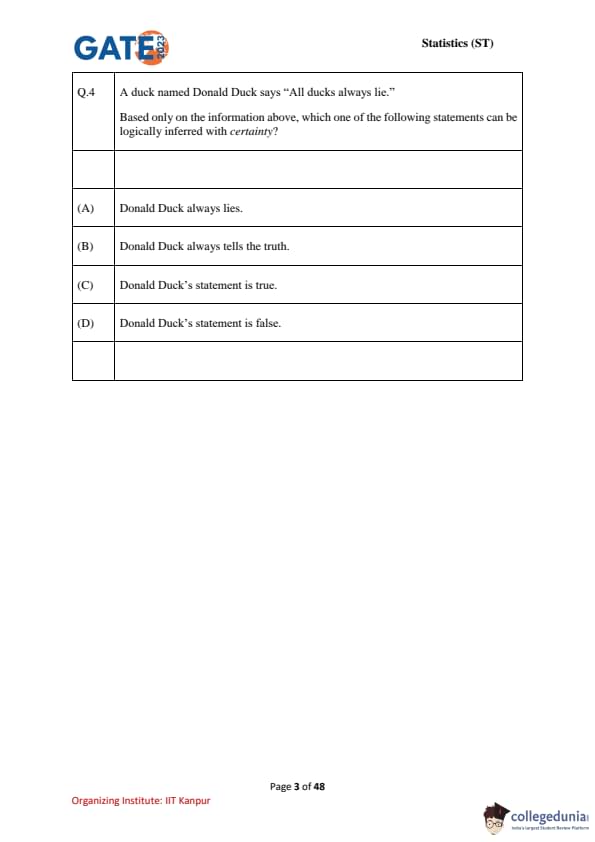
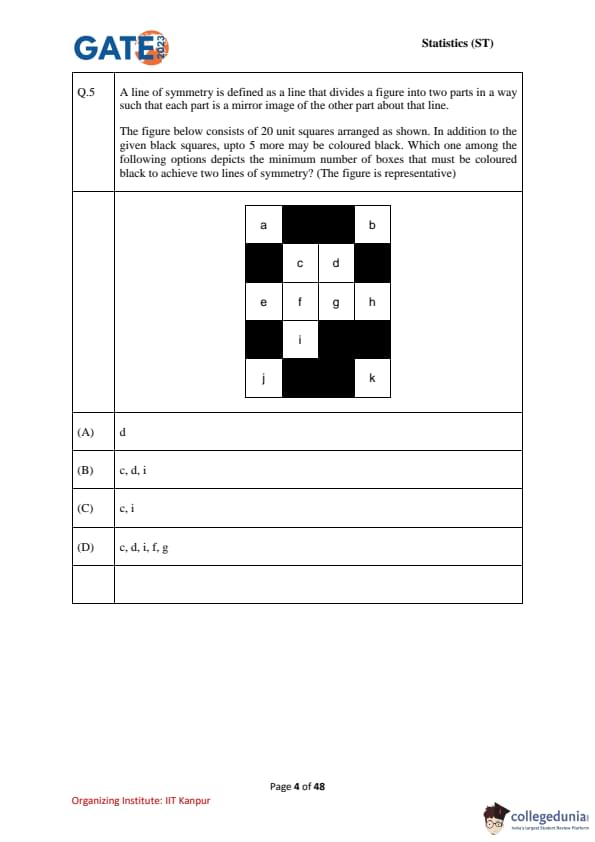
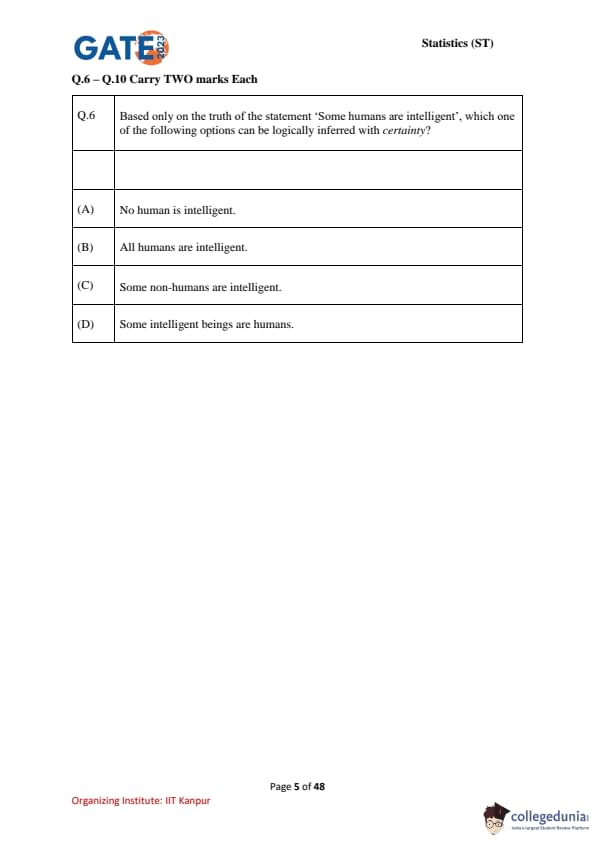

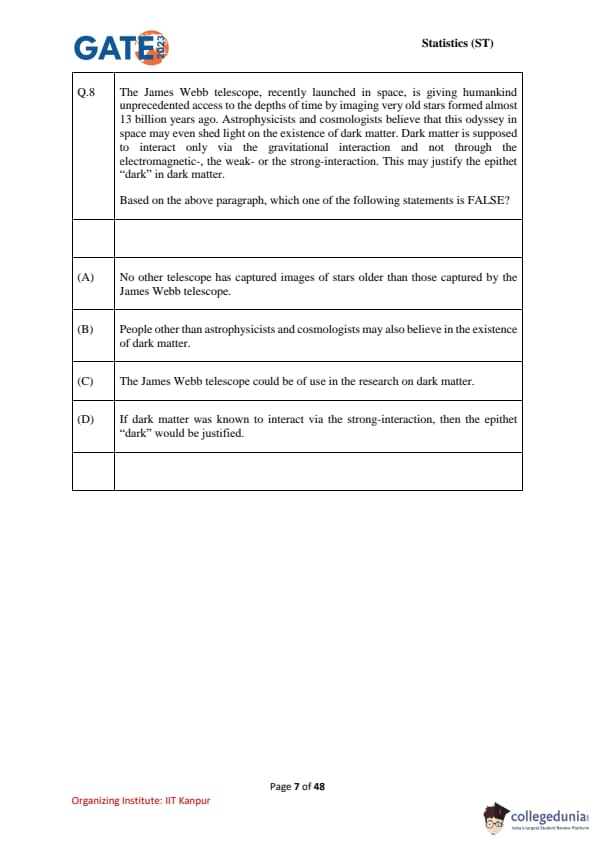
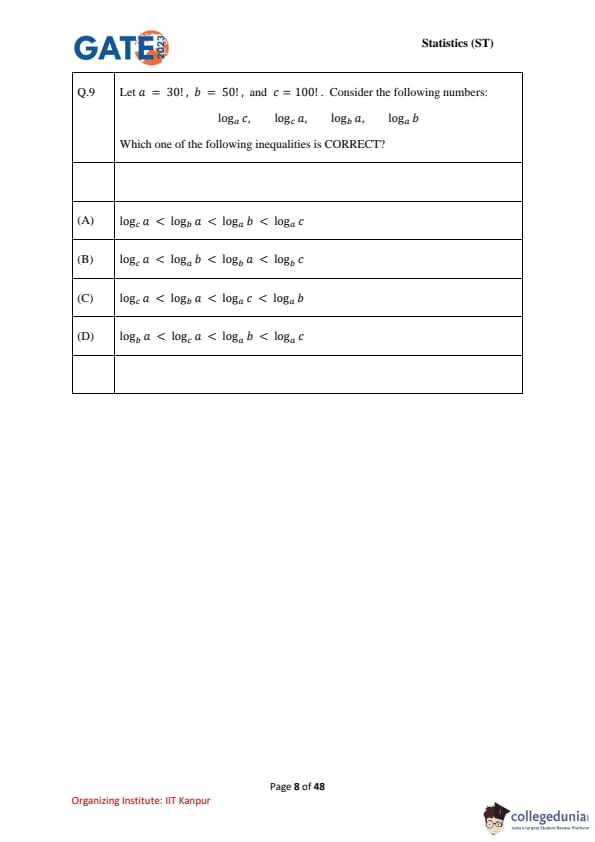
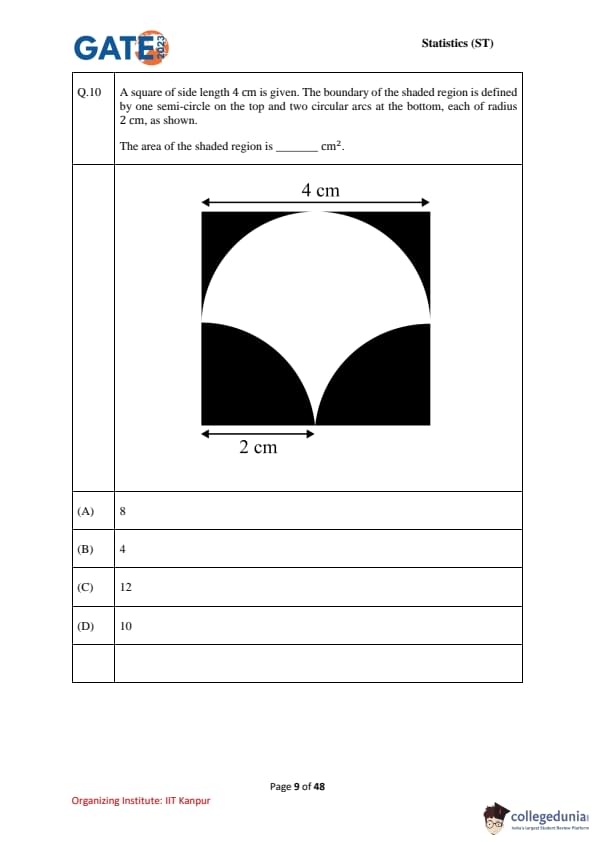
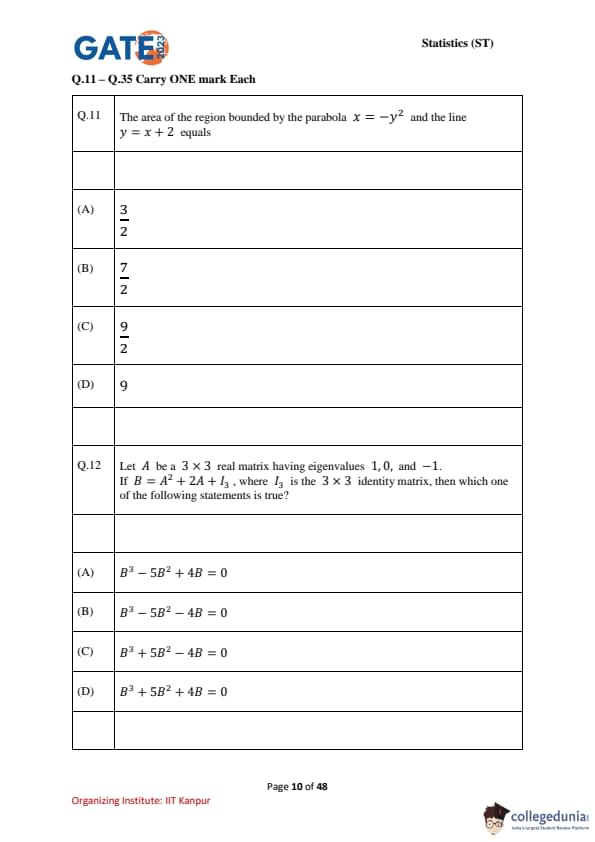
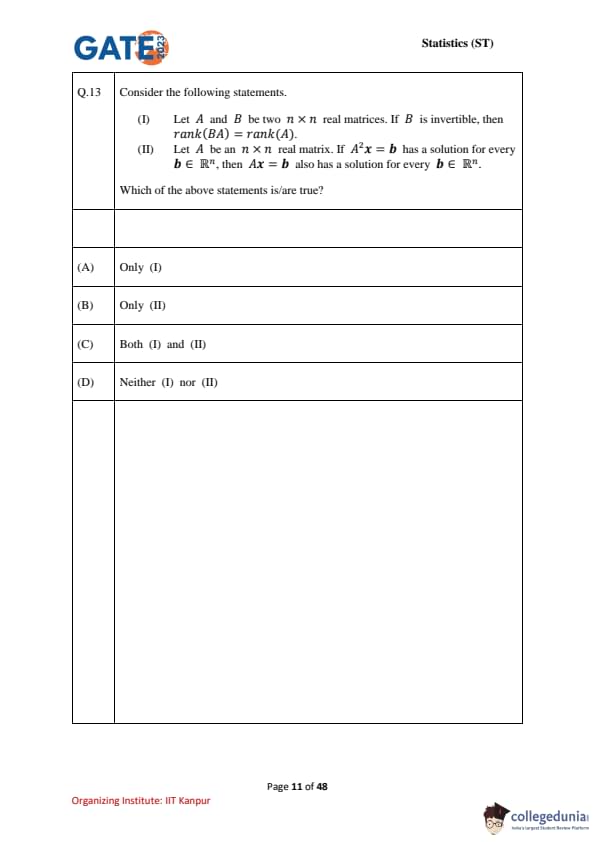
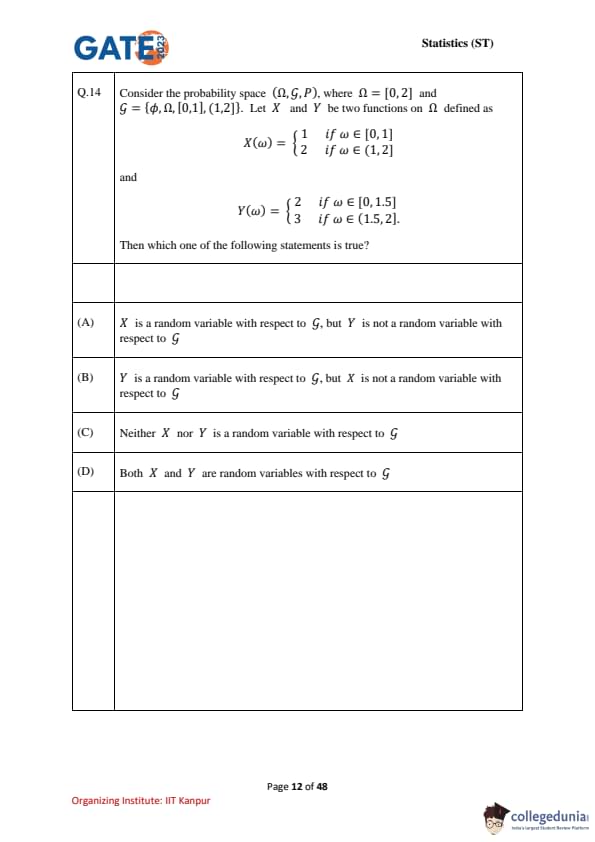
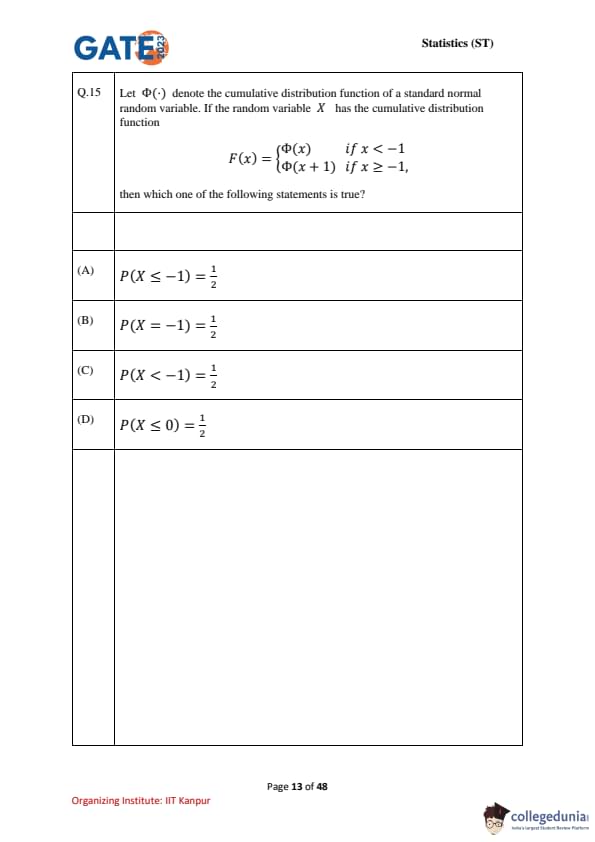
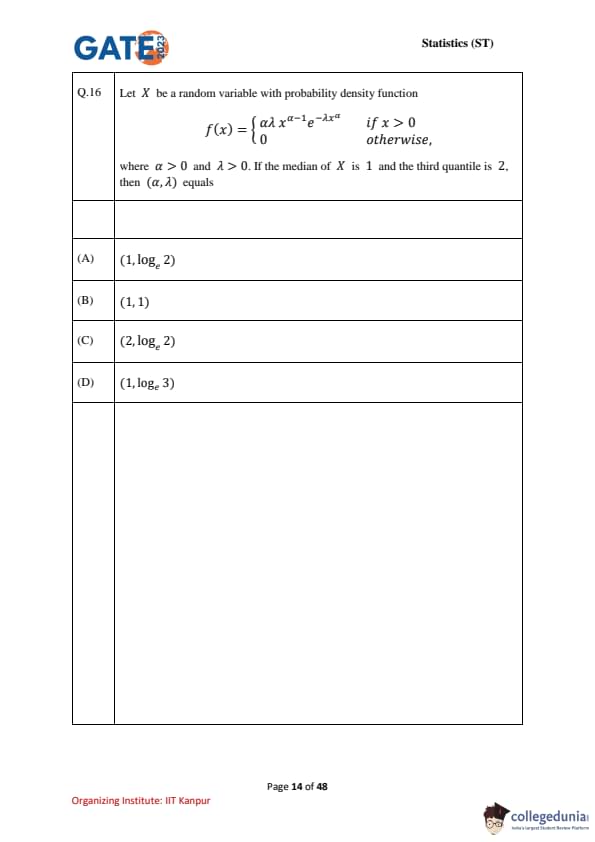
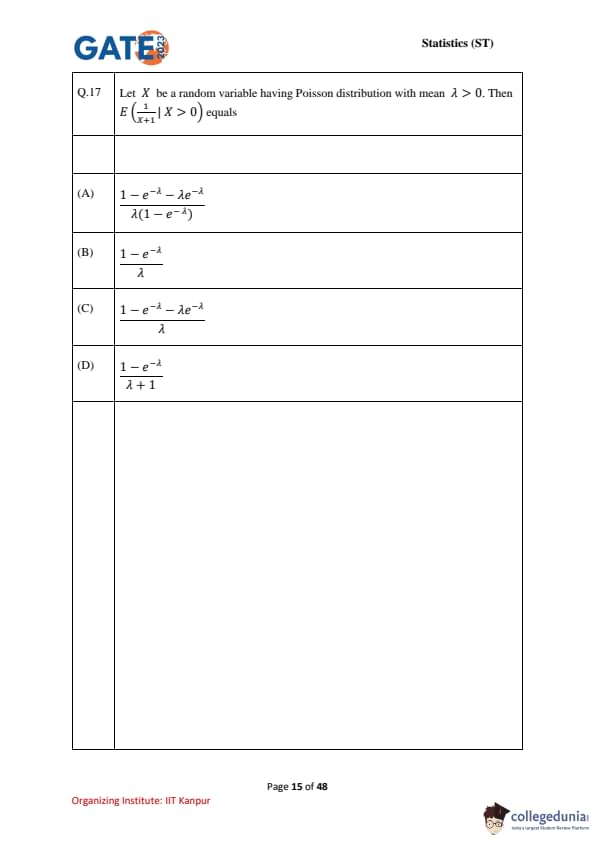


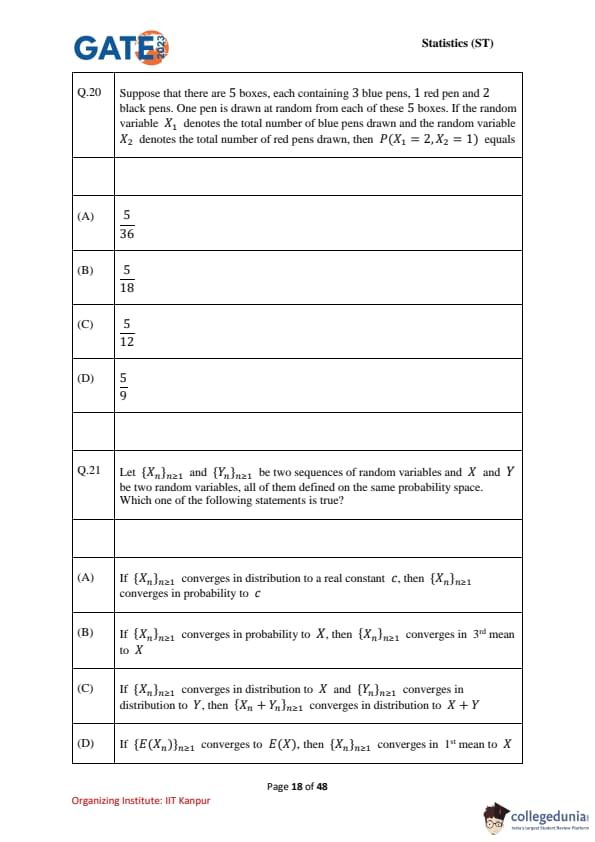

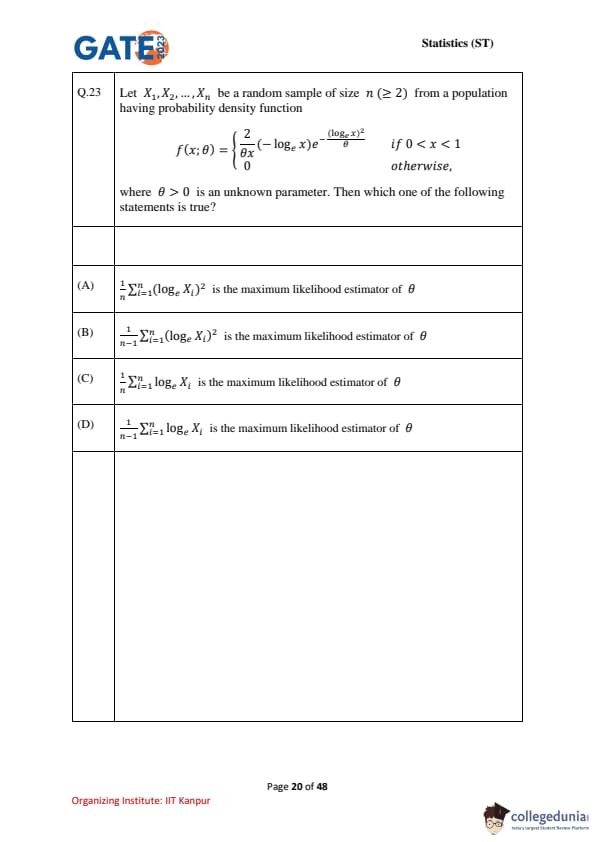


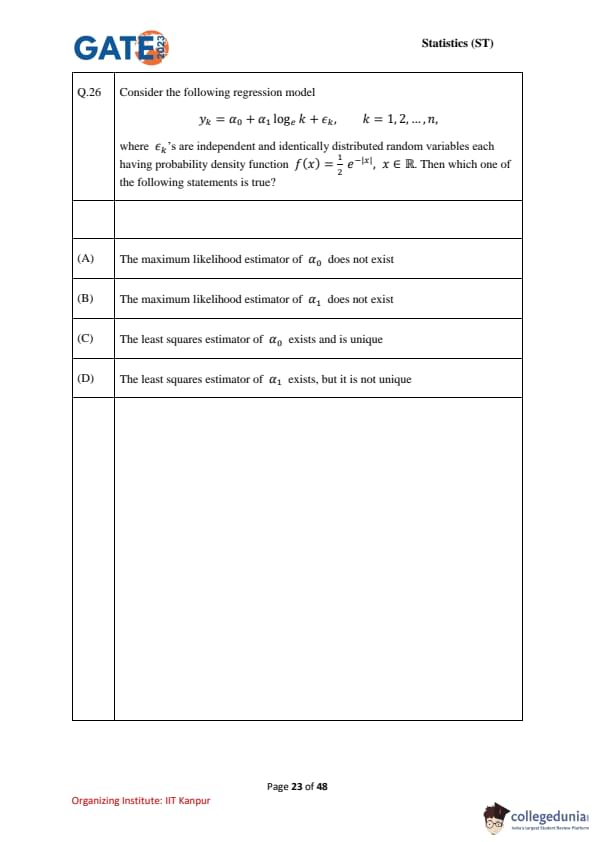
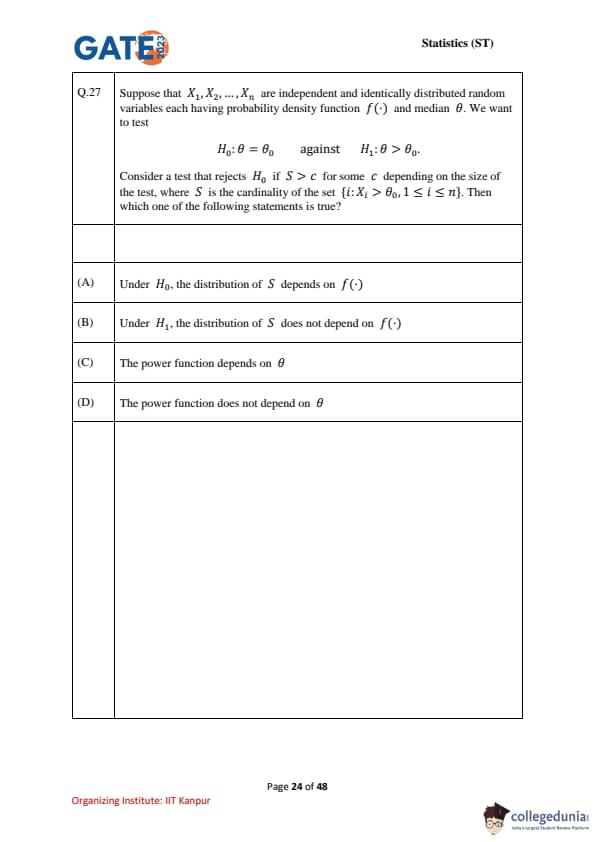


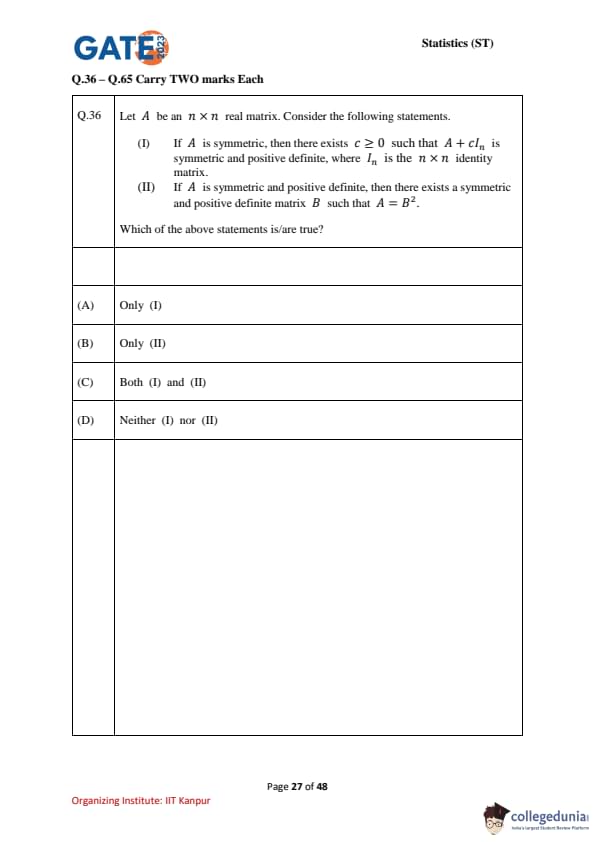
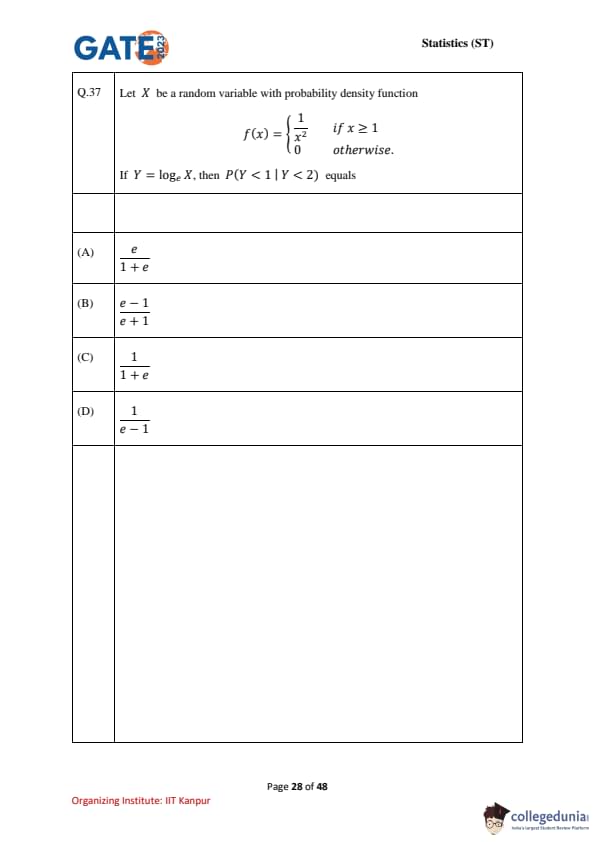
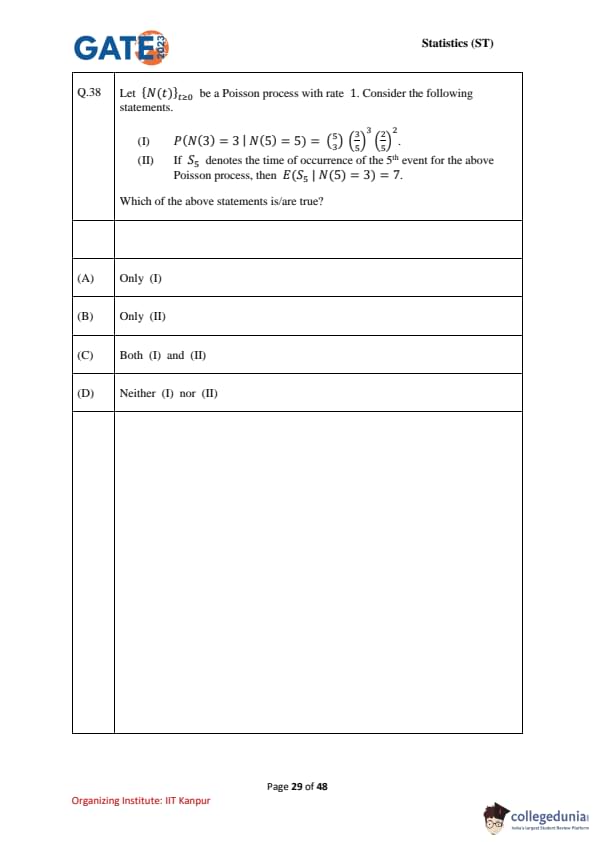
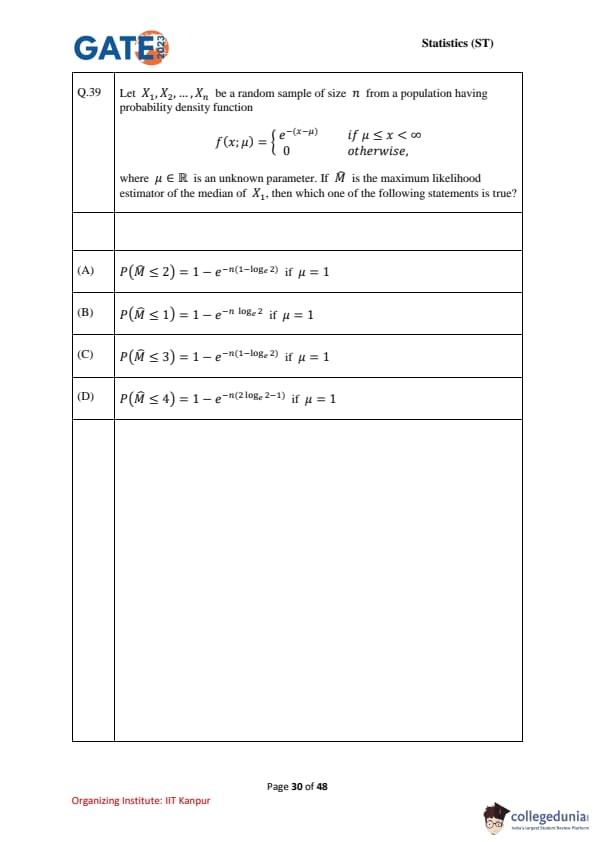
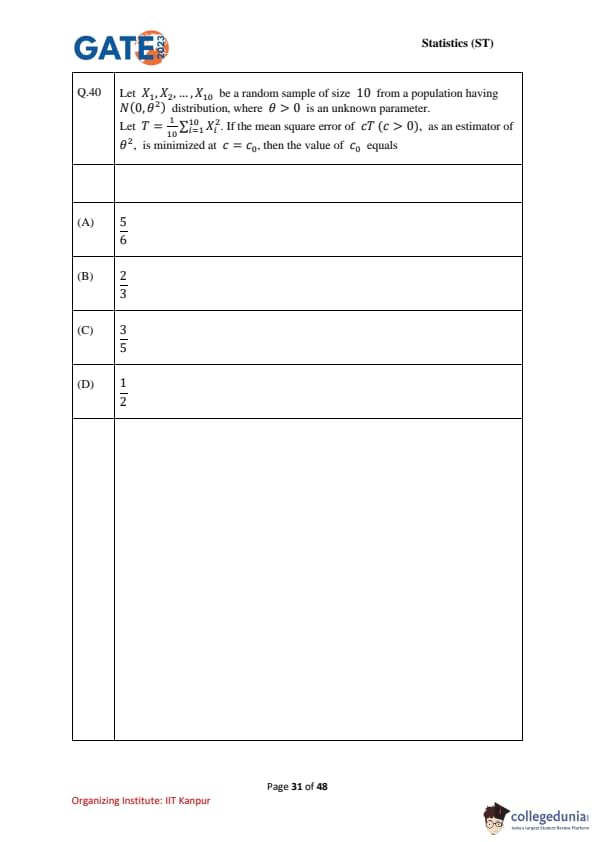

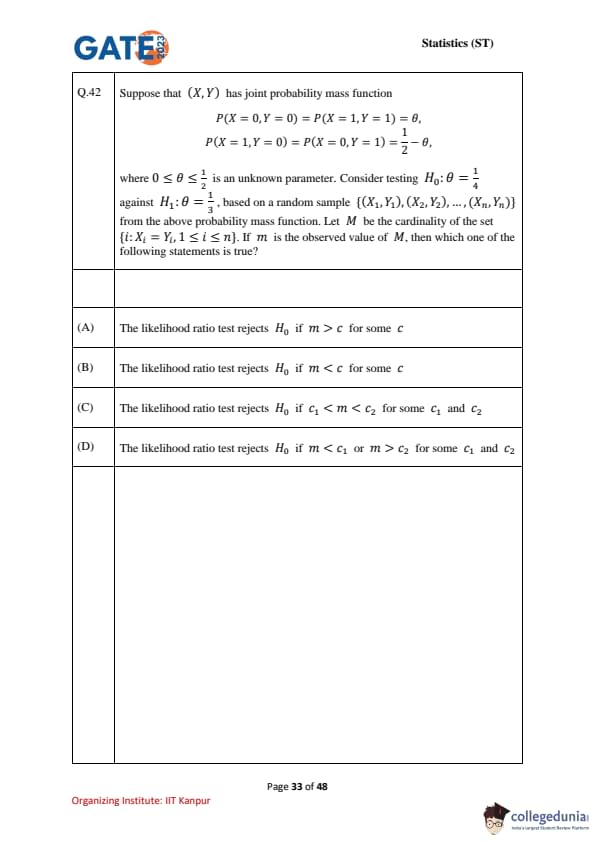
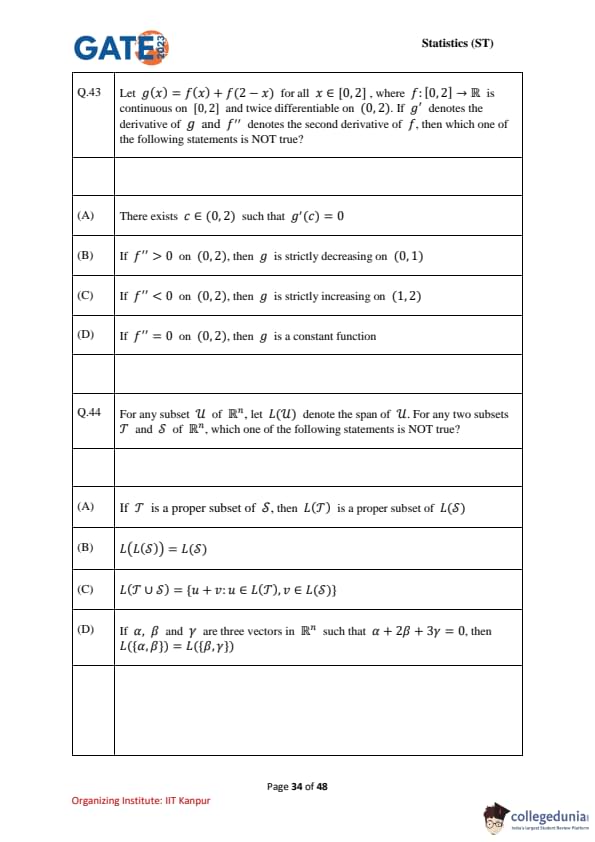
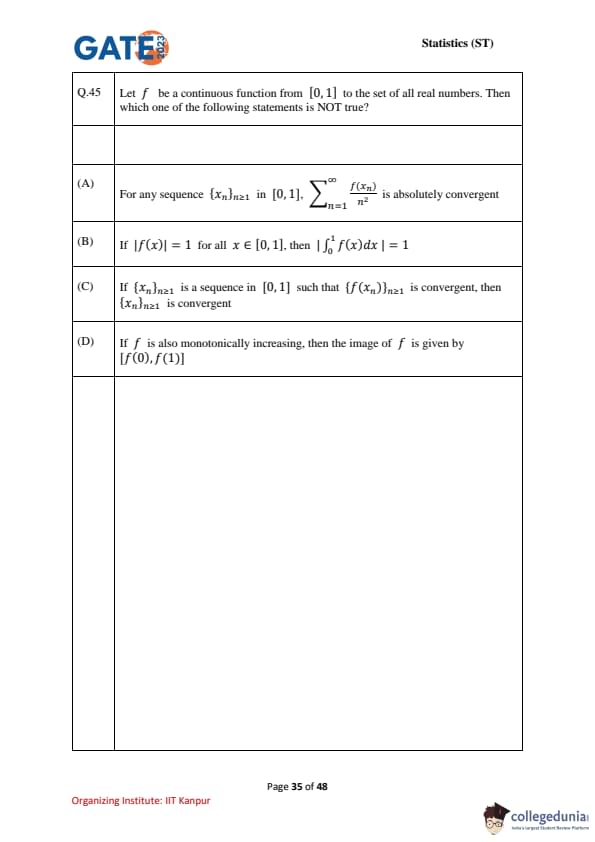

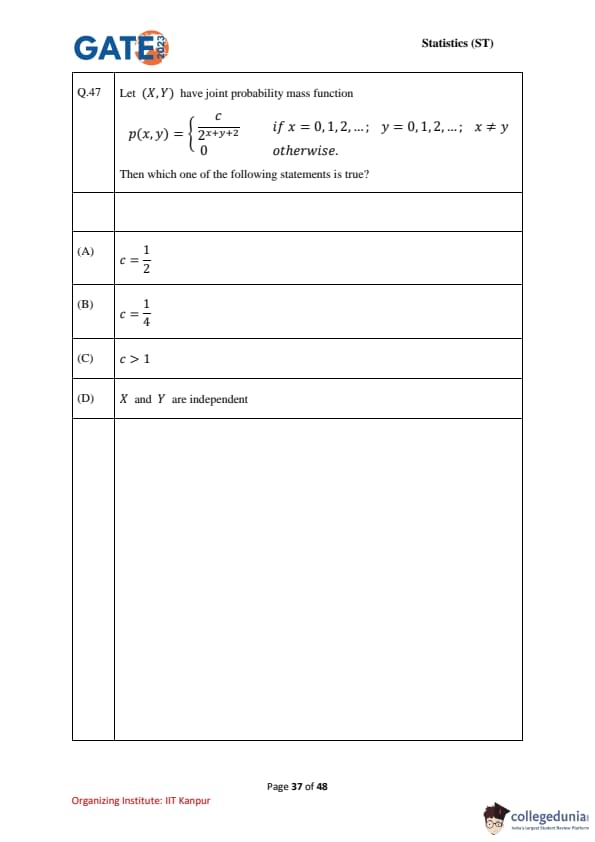



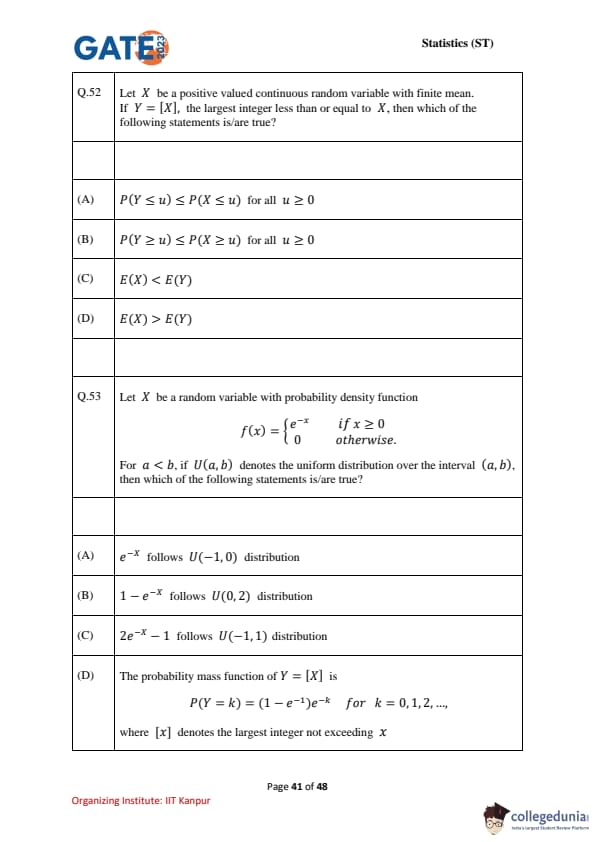


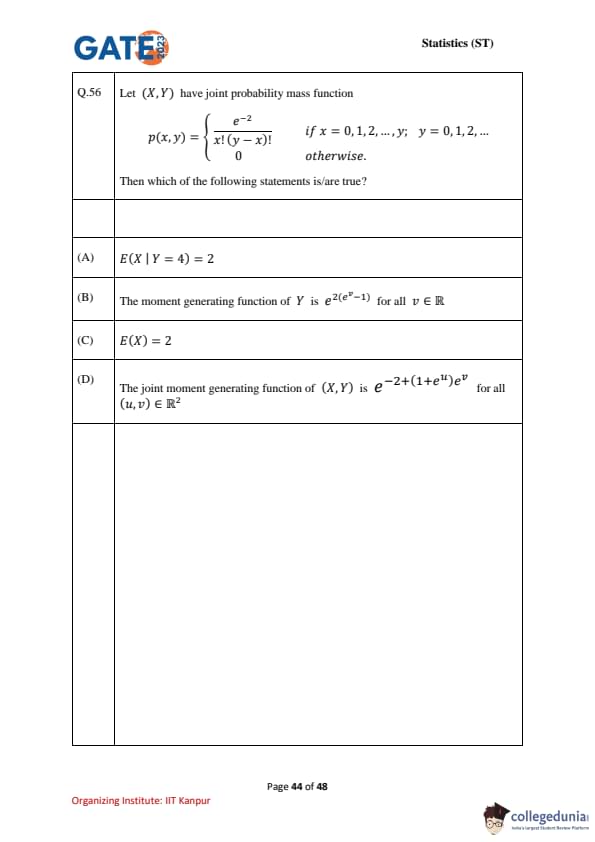
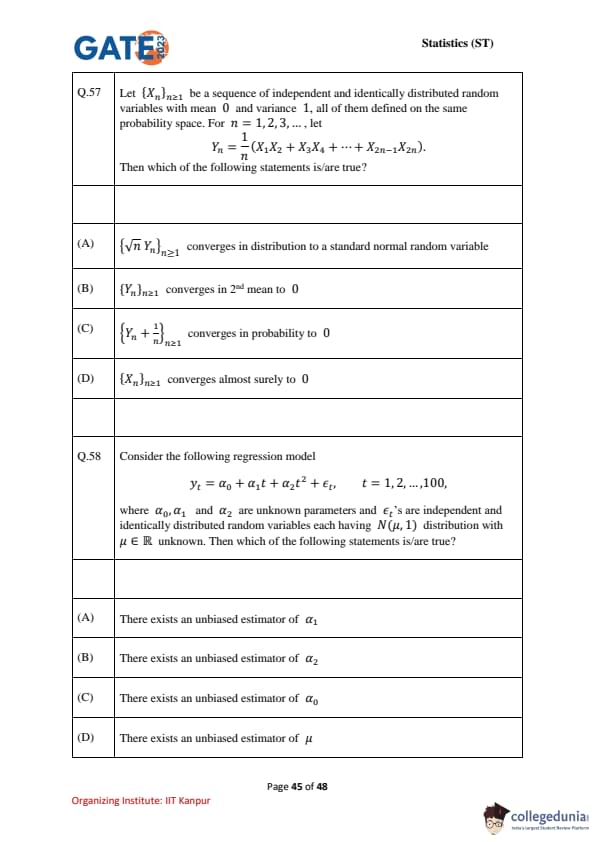
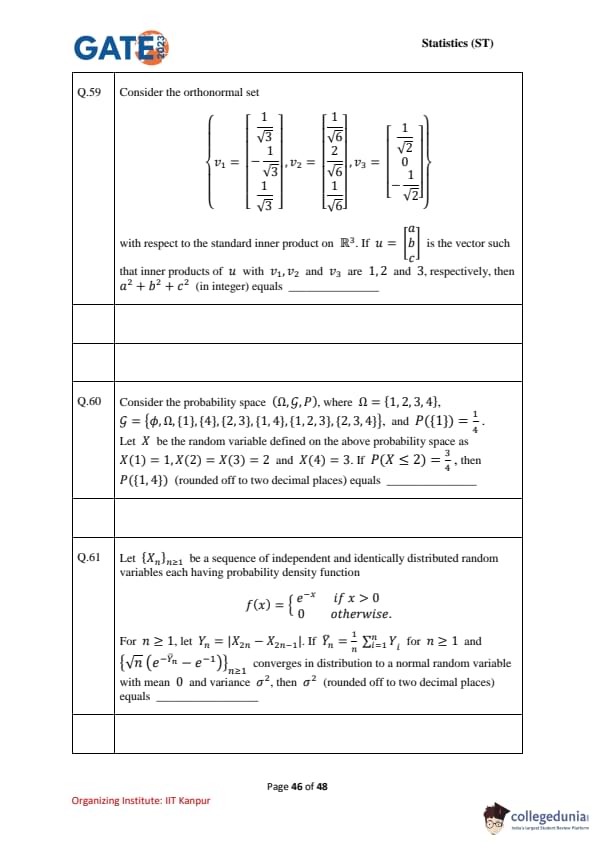
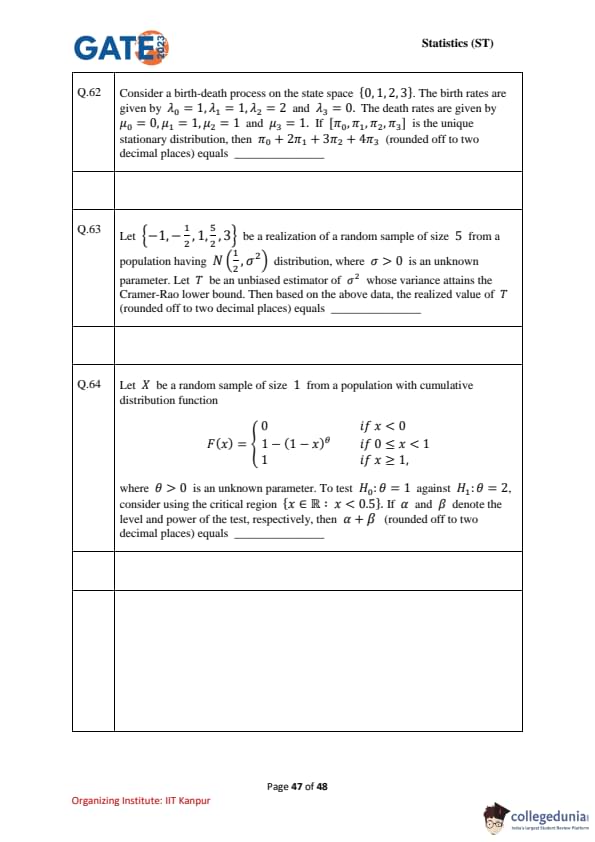
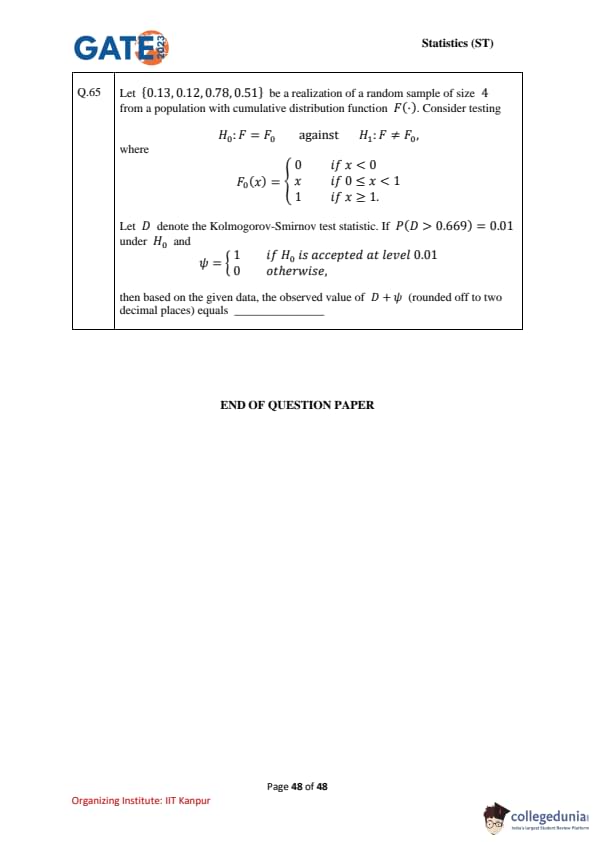

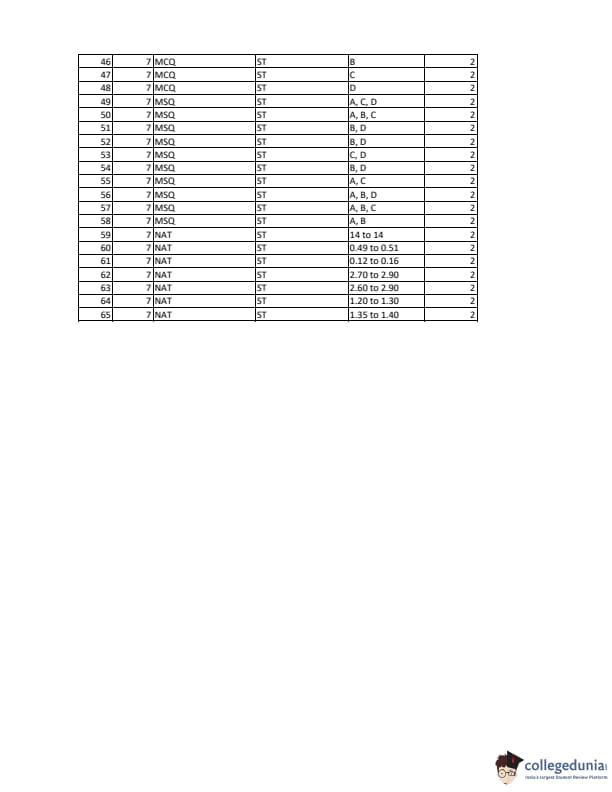
Also Check:
| Previous Year GATE Statistics Question Papers | GATE 2023 Statistics Paper Analysis |
| GATE Statistics Exam Pattern | GATE Statistics Syllabus |



Comments